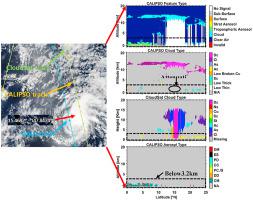当前位置:
X-MOL 学术
›
Atmos. Environ.
›
论文详情
Our official English website, www.x-mol.net, welcomes your
feedback! (Note: you will need to create a separate account there.)
Global distribution of maritime low clouds with an emphasis on different aerosol types and meteorological parameters inferred from multi-satellite and reanalysis data during 2007–2016
Atmospheric Environment ( IF 4.2 ) Pub Date : 2021-02-01 , DOI: 10.1016/j.atmosenv.2020.118082 Baiwan Pan , Dantong Liu , Kanike Raghavendra Kumar , Min Wang , N.S.M.P. Latha Devi
Atmospheric Environment ( IF 4.2 ) Pub Date : 2021-02-01 , DOI: 10.1016/j.atmosenv.2020.118082 Baiwan Pan , Dantong Liu , Kanike Raghavendra Kumar , Min Wang , N.S.M.P. Latha Devi

|
Abstract The present study investigates the comparison of spatiotemporal distributions of maritime cloud top height (CTH) and aerosol optical depth (AOD) based on level 3 products of the Cloud-Aerosol Lidar and Infrared Pathfinder Satellite Observations (CALIPSO) and Moderate-resolution Imaging Spectroradiometer (MODIS) sensors. Besides, the latest cloud and aerosol products from CALIPSO and Modern Era Retrospective-Analysis for Research (MERRA-2) reanalysis meteorology variables, the response of marine low cloud amount (LCA) as the function of occurrence frequencies of different aerosols (AOF), including clean marine (CM), Desert Dust (DD), and Dusty Marine (DM, the mixed type of CM and DD) are explored for the period 2007–2016. The study suggests, on an annual mean, the total agreement between CALIPSO and MODIS is 72.2%/69.5% during the daytime/nighttime for MLC (marine low cloud) and NMLC (not marine low cloud). It is revealed that the CALIPSO captures 11.4%/15.3% of MLC and 88.6%/84.7% of NMLC. While the MODIS captures 20.4% MLC and 79.6% NMLC during both day and nighttimes, partly due to the misidentification of MLC as aerosols by MODIS. Meanwhile, the discrepancy of AOD between MODIS and CALIPSO is approximately 0.053 on the annual scale, which is likely caused by detection sensitivity and surface reflectance models. Further, we have noticed that the aerosol effects on MLC are dependent on their types. It is evident that the CM tends to invigorate MLC and promote more LCA, and DD inclines to inhibit MLC and contribute to less LCA. However, DM shows the net significant aerosol effect on MLC possibly due to the contrasting aerosol effect of CM and DD. We also found that these aerosol invigoration or suppression effects on MLC present the non-monotonic mode under the condition of heavy aerosol loading.
中文翻译:

海洋低云的全球分布,重点是从 2007-2016 年多卫星和再分析数据推断的不同气溶胶类型和气象参数
摘要 本研究基于云-气溶胶激光雷达和红外探路卫星观测 (CALIPSO) 和中分辨率成像光谱仪的 3 级产品,研究了海洋云顶高度 (CTH) 和气溶胶光学深度 (AOD) 的时空分布比较。 (MODIS) 传感器。此外,CALIPSO的最新云和气溶胶产品和现代研究回顾分析(MERRA-2)再分析气象变量,海洋低云量(LCA)作为不同气溶胶发生频率(AOF)的函数的响应,包括清洁海洋 (CM)、沙漠尘埃 (DD) 和尘土飞扬的海洋 (DM,CM 和 DD 的混合类型) 在 2007-2016 年期间进行了探索。该研究表明,按年平均值计算,CALIPSO 和 MODIS 之间的总一致性为 72.2%/69。MLC(海洋低云)和 NMLC(非海洋低云)在白天/夜间为 5%。结果表明,CALIPSO 捕获了 11.4%/15.3% 的 MLC 和 88.6%/84.7% 的 NMLC。虽然 MODIS 在白天和夜间捕获 20.4% MLC 和 79.6% NMLC,部分原因是 MODIS 将 MLC 错误识别为气溶胶。同时,MODIS和CALIPSO之间的AOD在年尺度上的差异约为0.053,这可能是由探测灵敏度和表面反射模型引起的。此外,我们注意到气溶胶对 MLC 的影响取决于它们的类型。很明显,CM倾向于激发MLC并促进更多的LCA,而DD倾向于抑制MLC并导致更少的LCA。然而,DM 显示对 MLC 的净显着气溶胶影响可能是由于 CM 和 DD 的对比气溶胶效应。
更新日期:2021-02-01
中文翻译:

海洋低云的全球分布,重点是从 2007-2016 年多卫星和再分析数据推断的不同气溶胶类型和气象参数
摘要 本研究基于云-气溶胶激光雷达和红外探路卫星观测 (CALIPSO) 和中分辨率成像光谱仪的 3 级产品,研究了海洋云顶高度 (CTH) 和气溶胶光学深度 (AOD) 的时空分布比较。 (MODIS) 传感器。此外,CALIPSO的最新云和气溶胶产品和现代研究回顾分析(MERRA-2)再分析气象变量,海洋低云量(LCA)作为不同气溶胶发生频率(AOF)的函数的响应,包括清洁海洋 (CM)、沙漠尘埃 (DD) 和尘土飞扬的海洋 (DM,CM 和 DD 的混合类型) 在 2007-2016 年期间进行了探索。该研究表明,按年平均值计算,CALIPSO 和 MODIS 之间的总一致性为 72.2%/69。MLC(海洋低云)和 NMLC(非海洋低云)在白天/夜间为 5%。结果表明,CALIPSO 捕获了 11.4%/15.3% 的 MLC 和 88.6%/84.7% 的 NMLC。虽然 MODIS 在白天和夜间捕获 20.4% MLC 和 79.6% NMLC,部分原因是 MODIS 将 MLC 错误识别为气溶胶。同时,MODIS和CALIPSO之间的AOD在年尺度上的差异约为0.053,这可能是由探测灵敏度和表面反射模型引起的。此外,我们注意到气溶胶对 MLC 的影响取决于它们的类型。很明显,CM倾向于激发MLC并促进更多的LCA,而DD倾向于抑制MLC并导致更少的LCA。然而,DM 显示对 MLC 的净显着气溶胶影响可能是由于 CM 和 DD 的对比气溶胶效应。











































 京公网安备 11010802027423号
京公网安备 11010802027423号